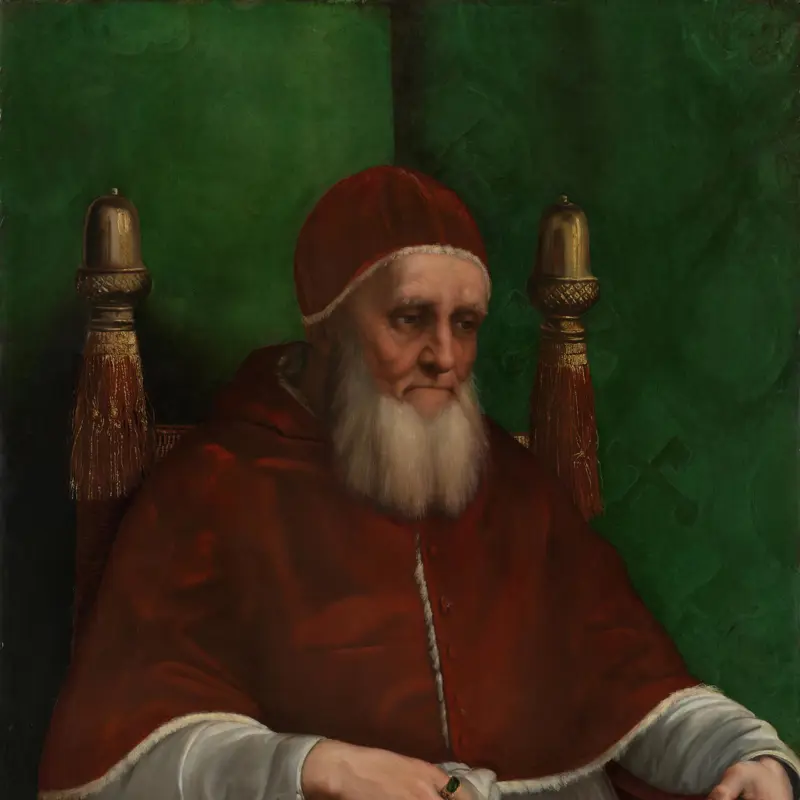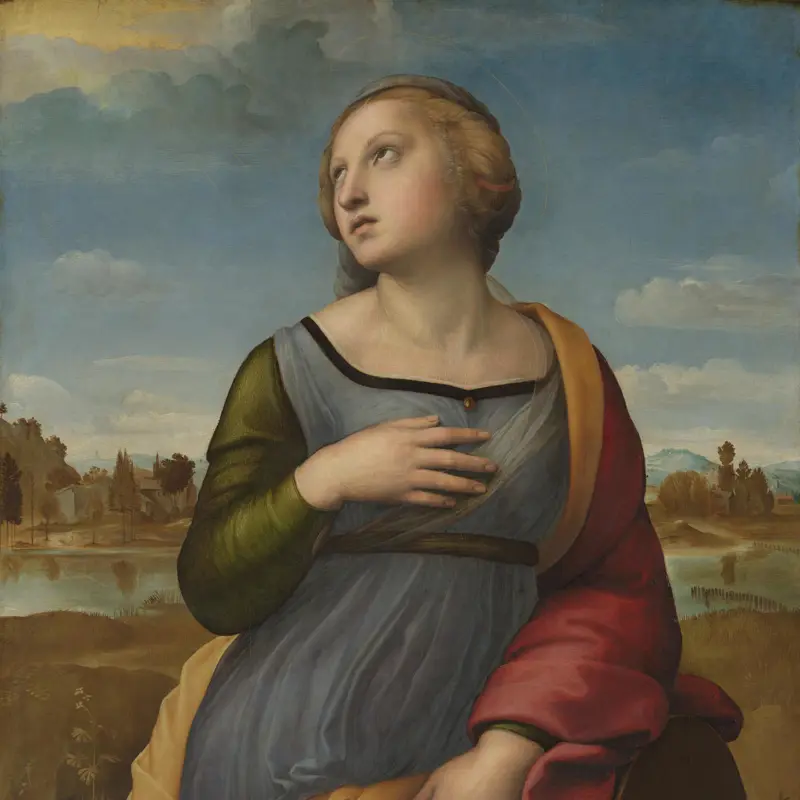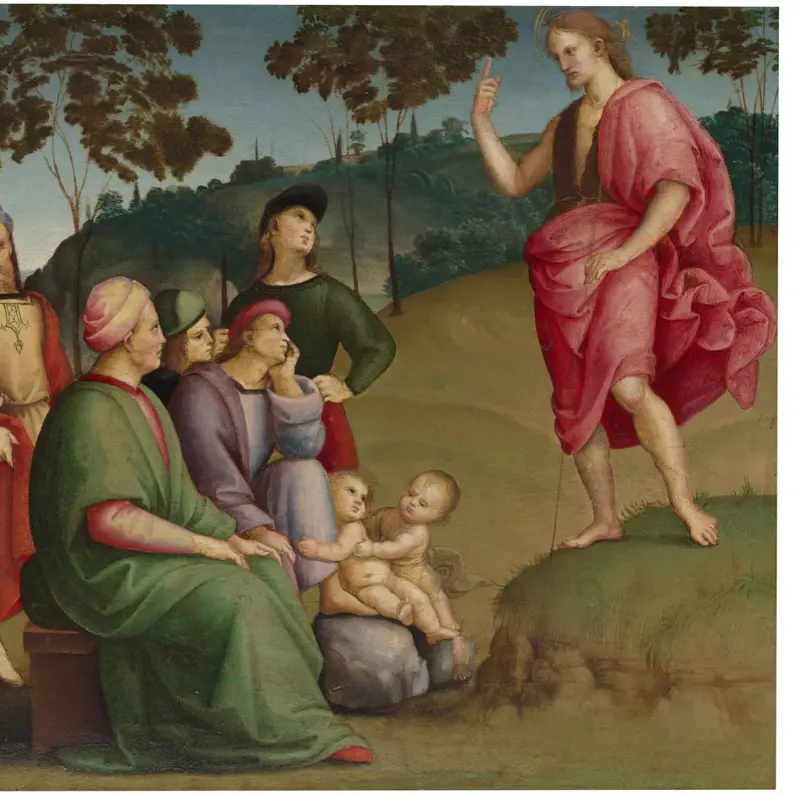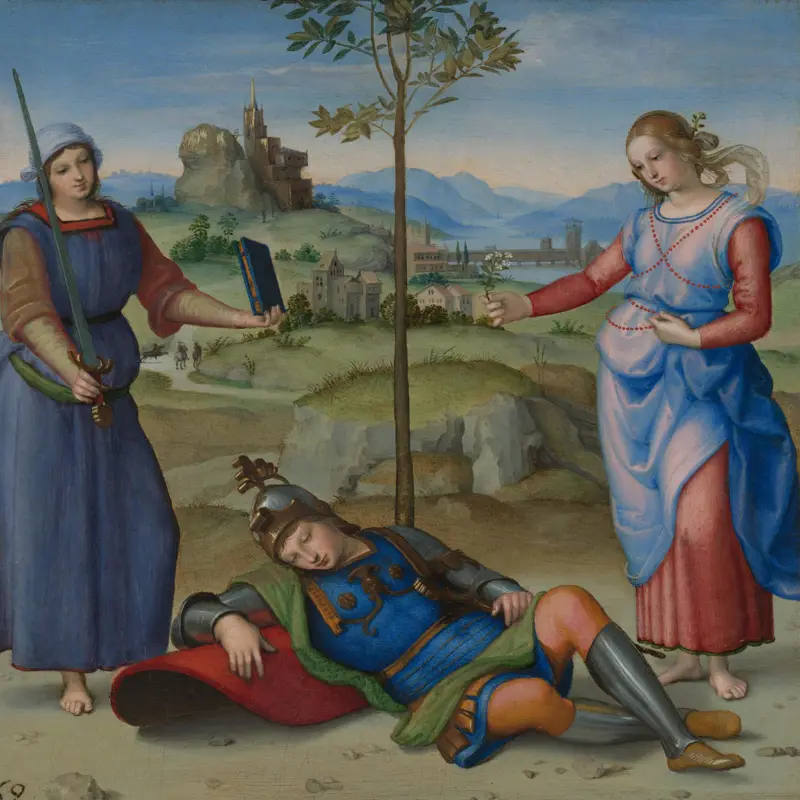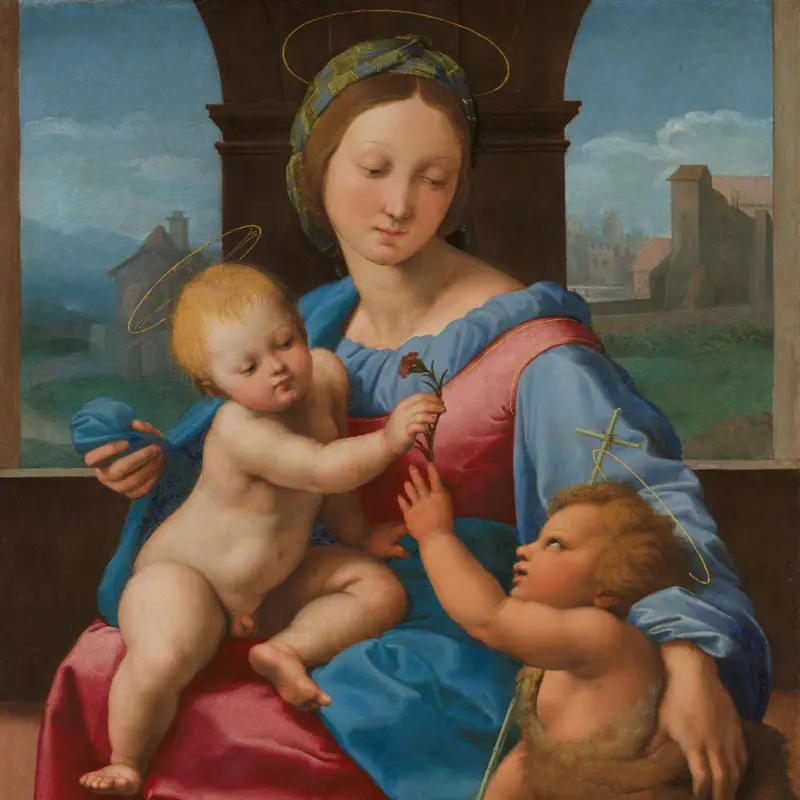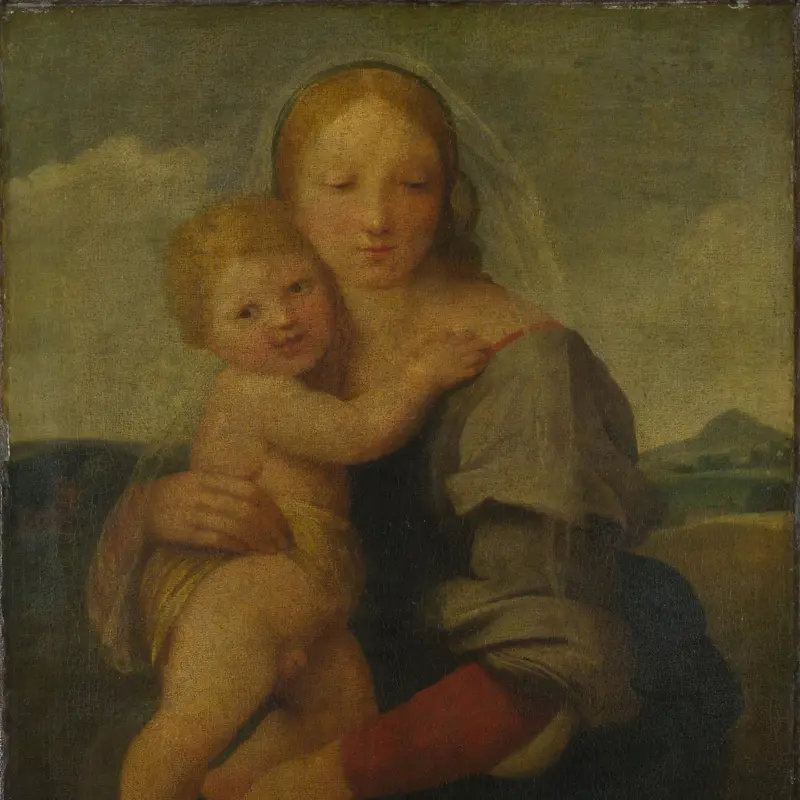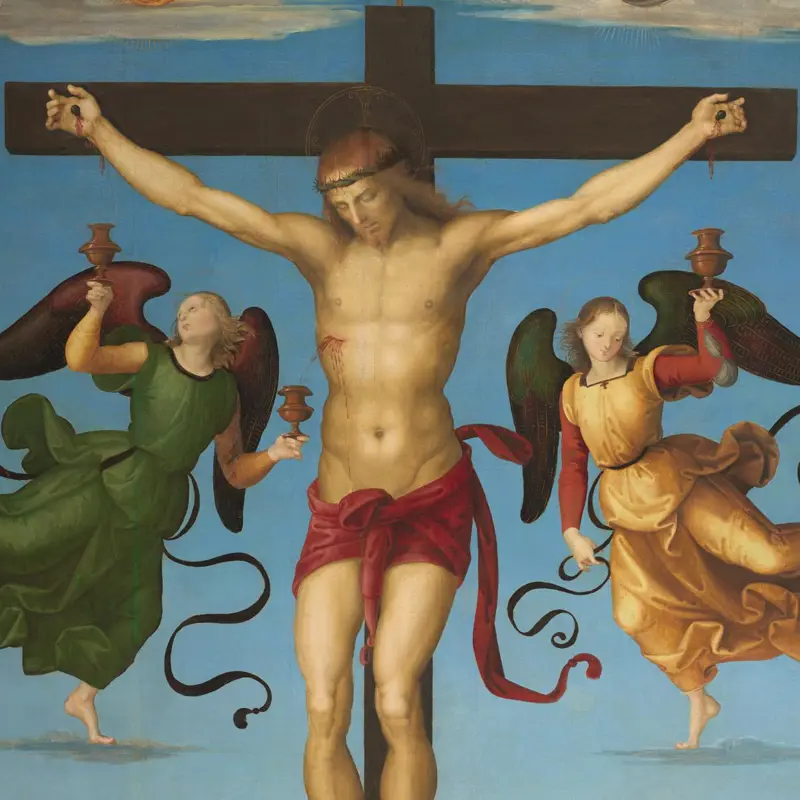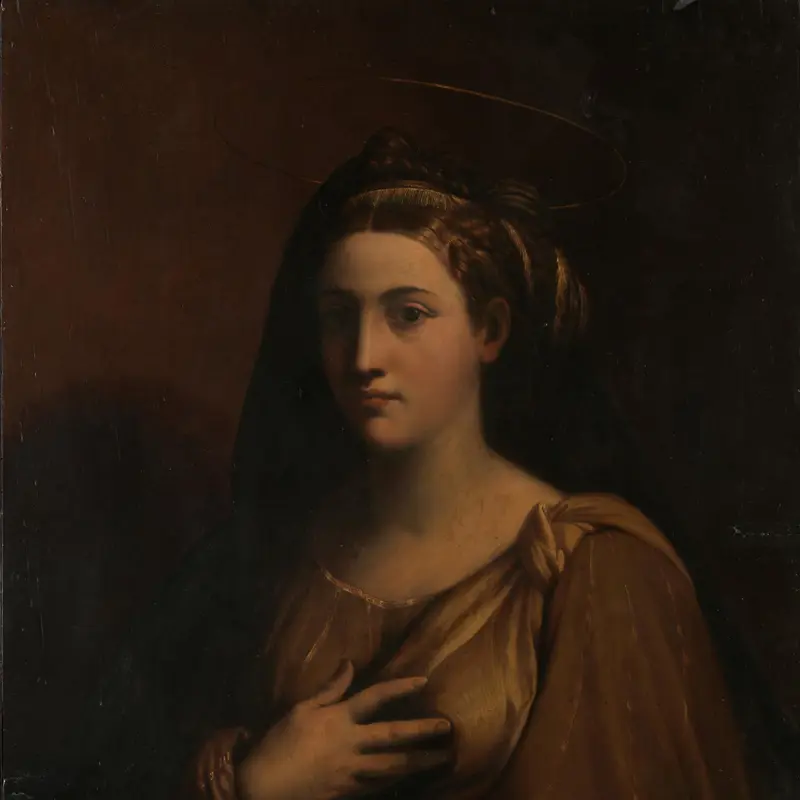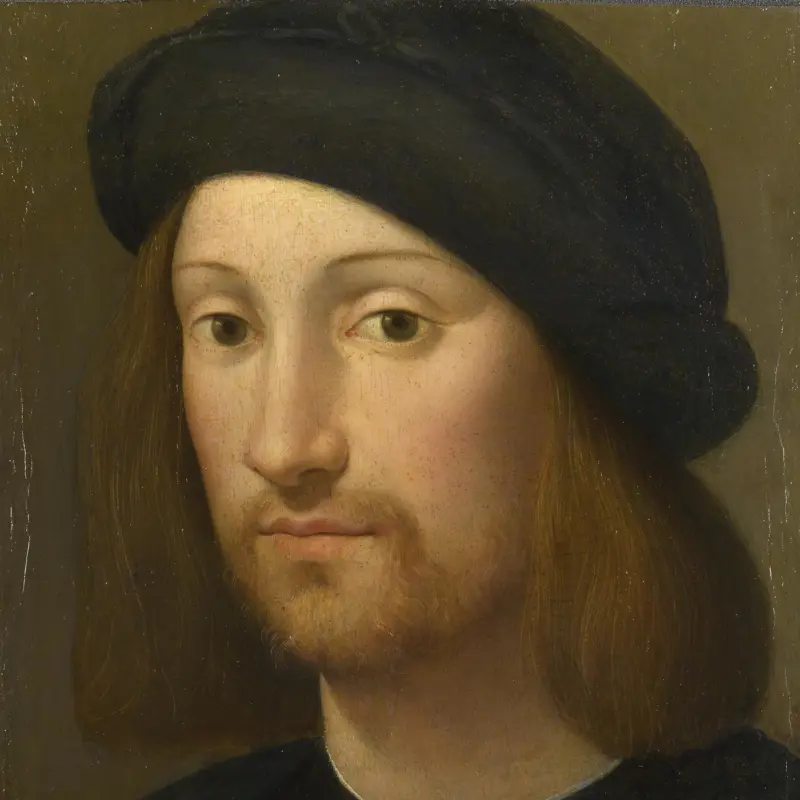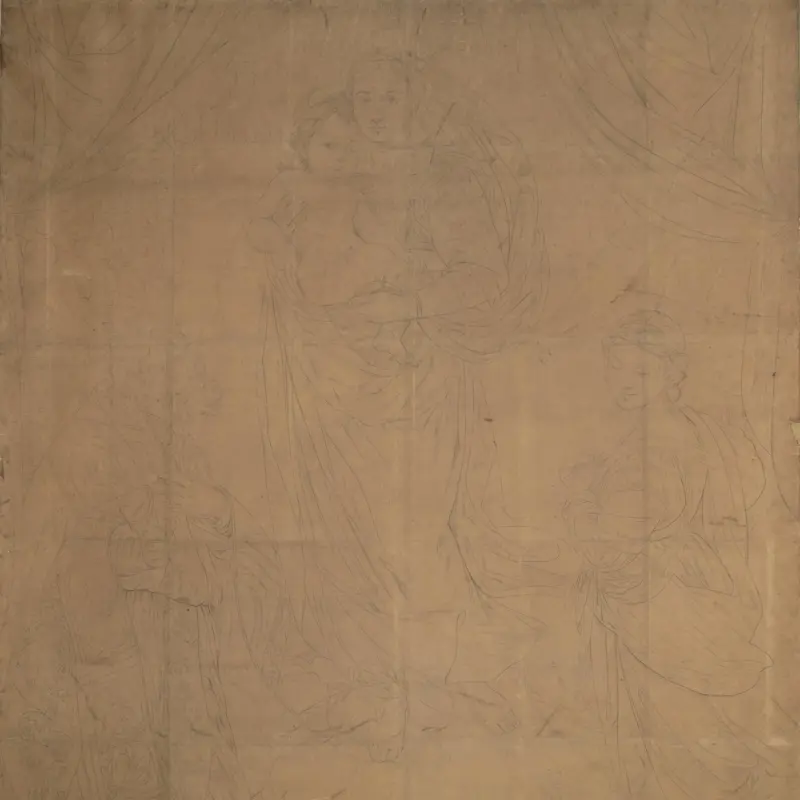Raphael, 'The Madonna of the Pinks ('La Madonna dei Garofani')', about 1506-7
About the work
Overview
In this painting, Raphael transforms the familiar subject of the Virgin and Child into something entirely new. The figures are no longer posed stiffly and formally as in paintings by earlier artists, but display all the tender emotions one might expect between a young mother and her child. The pair are seated in a bedchamber in an Italian Renaissance palace, and exchange carnations, which are symbolic of divine love and of Christ’s Passion (his torture and crucifixion).
This small picture may have been intended to be held in the hand for prayer and contemplation.
It is freely based on Leonardo da Vinci’s Benois Madonna (State Hermitage Museum, St Petersburg). For more than a century it was believed to be a copy, but it was rediscovered in 1991 as an original painting by Raphael.
Audio description
Listen to an audio description of Raphael's 'The Madonna of the Pinks'
Transcript
This is a description of 'The Madonna of the Pinks' ('La Madonna dei Garofani') by Raphael. It is oil on yew, painted between 1506 and 1507. It is relatively small, measuring just under 28 cm high and about 22 cm wide, which suggests that it may have been made to be held in the hand, for intimate prayer. It sits within a thick, gold frame, plainly decorated with textured bands.
The painting depicts an interior scene of a mother and child. The two serene figures take up most of the painting. The mother figure, or, the Madonna of the Pinks, is seated, her body angled towards the right. Her attention is given fully over to her child, head tilted down, as she gazes lovingly at the infant Christ on her lap.
She wears a grey silk dress, the bodice exposing her neck and shoulders. It has elbow length sleeves over the longer wrist-length sleeves of a gold silk underdress. Her dark blond hair is tied back, a translucent veil draped over her head and falling to her shoulder. The thinnest, barely perceptible, golden halo hovers over her head, alluding to her identity as the Virgin Mary.
On the left-hand side of the painting, hangs a green curtain, knotted to hold it back. It contains different hues: lime green, khaki, and emerald. The inclusion of the curtain hints that this is a personal space, perhaps the Madonna’s bedchamber.
An arched window in the top right, is partly cut off by the edge of the painting. It draws our focus to the landscape outside, perhaps an allusion to the bridge between the heavenly and the earthly. This outside scene is made up of blue sky, with white clouds above a green hill and a castle. It has a crenelated tower on the right, and an impression of a ruin on the left. In painting this window, Raphael has gone to the trouble of including the damage to the windowsill, where there is a small chip on the stone . This is depicted by a dab of white paint, placed at the very edge of the painting.
In spite of the daylight through the window, the light that encloses the mother and child does not seem to be coming from there, coming instead from the left.
The infant Jesus sits on a soft, white cushion on his mother’s knees, which are draped with blue silk. Completely naked, he is turned towards her, cherub-like, with plump legs and cheeks, dimpled arms, and light blond hair. One leg rests across her thigh, the other dangles down, foot pointing towards the bottom right-hand corner of the canvas. He is lifting his arms towards his mother, his gaze on two flowers in his
hands. He is either taking these from his mother or giving them to her, as she tenderly holds her right hand beneath his. Her left arm is supporting him from behind, and in that hand, she holds two more of the same flowers.
These flowers have been identified as carnations, also known as ‘pinks’, giving the painting its title. This flower was a traditional symbol of divine love and was said to have grown from the earth where the Virgin’s tears fell during Christ’s Passion.
Key facts
Details
- Full title
- The Madonna of the Pinks ('La Madonna dei Garofani')
- Artist
- Raphael
- Artist dates
- 1483 - 1520
- Date made
- about 1506-7
- Medium and support
- oil on wood
- Dimensions
- 27.9 × 22.4 cm
- Acquisition credit
- Bought with the assistance of the Heritage Lottery Fund, the Art Fund (with a contribution from the Wolfson Foundation), the American Friends of the National Gallery, London, the George Beaumont Group, Sir Christopher Ondaatje and through public appeal, 2004
- Inventory number
- NG6596
- Location
- Room 7
- Collection
- Main Collection
- Frame
- 16th-century Venetian Frame
Provenance
Additional information
Text extracted from the ‘Provenance’ section of the catalogue entry in Carol Plazzotta and Tom Henry, ‘National Gallery Catalogues: The Sixteenth Century Italian Paintings’, vol. 4, ‘Raphael’, London 2022; for further information, see the full catalogue entry.
Exhibition history
-
2010Close Examination: Fakes, Mistakes and DiscoveriesThe National Gallery (London)30 June 2010 - 12 September 2010
-
2014Raphael, Prince of PaintersTimken Museum of Art19 December 2014 - 26 April 2015
-
2015Masterpiece in Focus: Raphael, The Madonna of the PinksMinneapolis Institute of Art9 May 2015 - 16 August 2015
-
2020Raphael in Berlin: The Madonnas of the GemäldegalerieGemäldegalerie (Berlin)5 December 2019 - 14 June 2020
-
2022The Credit Suisse Exhibition: RaphaelThe National Gallery (London)9 April 2022 - 31 July 2022
Bibliography
-
1829F. Longhena (ed.), Istoria della vita e delle opere di Raffaello Sanzio da Urbino del signor Quatremere de Quincy, Milan 1829
-
1840A. Constantin, Idées italiennes sur quelques tableaux celebres, Florence 1840
-
1857G.F. Waagen, Treasures of Art in Great Britain: Being and Account of the Chief Collections of Paintings, Drawings, Sculptures, Illuminated Mss. […], translated from German by Elizabeth Eastlake, 3 vols, London 1857, vol. 3
-
1860J.D. Passavant, Raphaël d'Urbin et son père Giovanni Santi, Paris 1860
-
1882J.A. Crowe and G.B. Cavalcaselle, Raphael: His Life and Works, 2 vols, London 1882
-
1882E. Müntz, Raphael: His Life, Works and Times, trans. W. Armstrong, London 1882
-
1897B. Berenson, The Central Italian Painters of the Renaissance, New York 1897
-
1904A. Rosenberg, Raffael: Des Meisters Gemälde in 202 Abbildungen, Stuttgart 1904
-
1913S. de Ricci, Description raisonnée des peintures du Musée du Louvre: Écoles étrangéres: Italie et Espagne, Paris 1913
-
1923A. Rosenberg, Raffael, des Meisters Gemälde, in 274 Abbildungen, ed. G. Gronau, Berlin 1923
-
1934G. Gronau et al., 'Interessante Probleme', Belvedere, 1934
-
1941W. Suida, Raphael, London 1941
-
1948O. Fischel, Raphael, trans. B. Rackham, London 1948
-
1958G. Gamulin, 'Una copia della Madonna del Garofano', Commentari, IX, 1958, pp. 160-1
-
1963R. Holland, Noble Patronage: An Exhibition devoted to the Activity of the Percy Family, Earls and Dukes of Northumberland, as Collectors and Patrons of the Art (exh. cat. Hatton Gallery, November - December 1963), Newcastle upon Tyne 1963
-
1966L. Düssler, Raffael: Kritisches Verzeichnis der Gemälde, Wandbilder und Bildteppiche, Munich 1966
-
1967M. Salmi, Il Palazzo e la collezione Chigi-Saracini, Siena: Monte dei Paschi di Siena 1967
-
1971L. Düssler, Raphael: A Critical Catalogue of His Pictures, Wall-Paintings and Tapestries, trans. S. Cruft, London 1971
-
1982P. de Vecchi, Tout l'oeuvre peint de Raphael, Paris 1982
-
1983J.-P. Cuzin, Raphaël et l'art français (exh. cat. Galeries Nationales du Grand Palais, 15 November 1983 - 13 February 1984), Paris 1983
-
1985G.B. Pezzini, S. Massari and S. Prosperi Valenti Rodinò, Raphael invenit: Stampe da Raffaello nelle collezioni dell'Istituto nazionale per la grafica catalogo, Rome 1985
-
1987G. Dalli Regoli, '"Non… da natura, ma per lungo studio": Riferimenti, citazione e rielaborazione nelle Madonne di Raffaello', in M. Sambucco Hamoud and M.L. Strocchi (eds), Studi su Raffaello: Atti del Congresso Internazionale di Studi Urbino and Florence, 6-14 April 1984, Urbino 1987, pp. 419-28
-
1987J.H. Beck, 'Raphael, Florence, and Quattrocento Sculpture', in M. Sambucco Hamoud and M.L. Strocchi (eds), Studi su Raffaello Atti del Congresso Internazionale di Studi, Urbino - Florence, 6-14 April 1984, Urbino 1987, pp. 73-8
-
1987G. Dalli Regoli, '"Non...da natura, ma per lungo studio": Riferimenti, citazione e rielaborazione nelle Madonne di Raffaello', in M. Sambucco-Hamoud and M.L. Strocchi (eds), Studi su Raffaello (Atti del Congresso Internazionale di Studi, Urbino - Florence, 6-14 April 1984), Urbino 1987, pp. 419-428
-
1992National Gallery, The National Gallery Report: April 1991 - March 1992, London 1992
-
1992C. McCorquodale, 'London: Raphael Re-Discovered in Northumberland Collection. Raphael's "Madonna of the Pinks" has Now been Firmly Reattributed after Cleaning', Art Newspaper, III, 1992
-
1992N. Penny, 'Raphael's "Madonna dei Garofani" Rediscovered', The Burlington Magazine, CXXXIV, 1992, pp. 67-81
-
1993J. Dunkerton and N. Penny, 'The Infra-Red Examination of Raphael's "Garvagh Madonna"', National Gallery Technical Bulletin, XIV, 1993, pp. 6-21
-
1994T. Clifford, J. Dick and A. Weston-Lewis, Raphael: The Pursuit of Perfection (exh. cat. National Gallery of Scotland, 5 May - 10 July 1994), Edinburgh 1994
-
1995P. de Vecchi, Raffaello: La mimesi, l'armonia e l'invenzione, Florence 1995
-
1996C. Baxter, The Camuccini Collection, S.l. 1996
-
1996J. Meyer zur Capellen, Raphael in Florence, trans. S.B. Polter, London 1996
-
1998H. Guratzsch, Maximilian Speck von Sternburg: Ein Europäer der Goethezeit als Kunstsammler (exh. cat. Museum der bildenden Künste Leipzig, 17 July - 13 September 1998; Haus der Kunst, 26 August - 24 October 1999), Leipzig 1998
-
1999M.B. Hall, After Raphael: Painting in Central Italy in the Sixteenth Century, Cambridge 1999
-
1999R. Freiherr Hiller von Gaertringen, Raffaels Lernerfahrungen in der Werkstatt Peruginos: Kartonverwendung und Motivübernahme im Wandel, Munich 1999
-
1999K. Oberhuber, Raphael: The Paintings, Munich 1999
-
1999C. Wagner, Farbe und Metapher: Die Entstehung einer neuzeitlichen Bildmetaphorik in der vorrömischen Malerei Raphaels, Berlin 1999
-
2001
C. Baker and T. Henry, The National Gallery: Complete Illustrated Catalogue, London 2001
-
2001J. Meyer zur Capellen, Raphael: A Critical Catalogue of His Paintings, vol. 1, Beginnings in Umbria and Florence, ca. 1500-1508, Landshut 2001
-
2002J. Fenton, 'Don't Take Our Raphael!', New York Review of Books, XLIX, 2002, pp. 50-2
-
2003National Gallery, The National Gallery Review: April 2002 - March 2003, London 2003
-
2003J. Shearman, Raphael in Early Modern Sources (1483-1602), New Haven 2003
-
2004National Gallery, The National Gallery Review: April 2003 - March 2004, London 2004
-
2004'Acquisition of the Year: The National Gallery, London, "The Madonna of the Pinks" by Raphael', Apollo, 2004
-
2004D. Cooper, 'New Documents for Raphael and His Patrons in Perugia', The Burlington Magazine, CXLVI, 2004, pp. 742-4
-
2004D. Ekserdjian, 'The Making of Raphael', Apollo, CLX, 2004, pp. 76-8
-
2004P. Joannides, 'Raphael: A Sorority of Madonnas', The Burlington Magazine, CXLVI, 2004, pp. 749-52
-
2004C. Plazzotta, 'Catalogue of Grants: London, National Gallery', National Art Collections Fund Review, 5420, 2004, pp. 86-7
-
2004A. Roy, M. Spring and C. Plazzotta, 'Raphael's Early Work in the National Gallery: Paintings before Rome', National Gallery Technical Bulletin, XXV, 2004, pp. 4-35
-
2004R. Shone, 'Editorial: Raphael seul est divin!', The Burlington Magazine, CXLVI, 2004
-
2004H. Chapman, T. Henry and C. Plazzotta, Raphael: From Urbino to Rome (exh. cat. The National Gallery, 20 October 2004 - 16 January 2005), London 2004
-
2005J.H. Beck, 'Raphael's Madonna of the Pinks: A Connoisseurship Challenge', Source, XXIV, 2005, pp. 50-9
-
2006J.H. Beck, From Duccio to Raphael: Connoisseurship in Crisis, Florence 2006
-
2007M. Spring, 'Raphael's Materials: Some New Discoveries and their Context within Early Sixteenth-Century Painting', in A. Roy and M. Spring (eds), Raphael's Painting Technique: Working Practices before Rome: Proceedings of the Eu-ARTECH Workshop, Florence 2007, pp. 77-86
-
2007A. Roy, 'The Re-Emergence of Raphael's Madonna of the Pinks', in A. Roy and M. Spring (eds), Raphael's Painting Technique: Working Practices before Rome: Proceedings of the Eu-ARTECH Workshop, Florence 2007, pp. 87-92
-
2022Plazzotta, Carol, and Tom Henry, National Gallery Catalogues: The Sixteenth Century Italian Paintings, 4, Raphael, London 2022
Frame
This sixteenth-century cassetta frame is from the Veneto region of Italy. The frame retains its original water-gilt surface. The back edge has a fillet and cavetto, which steps to the frieze. Using the pastiglia technique, the frieze has fine decorative double guilloches, which were press-moulded and glued onto the cushioned section, with the joining lines becoming visible over time. The inner moulding has an astragal, and steps to the cavetto sight edge.
In 2005, the current frame was donated to the Gallery by Mr and Mrs Ludovic de Walden, and was fitted to Raphael’s The Madonna of the Pinks.
About this record
If you know more about this work or have spotted an error, please contact us. Please note that exhibition histories are listed from 2009 onwards. Bibliographies may not be complete; more comprehensive information is available in the National Gallery Library.

